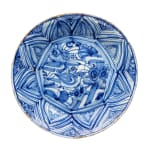Bacia "Desenho Geométrico" , Lisboa, 1610-1620
faiança portuguesa
Ø 31 cm
C663
Publications
ROQUE, Mário, Lisboa na Origem da Chinoiserie, Lisboa: São Roque, 2018 (pp. 52-53)
Magnífica bacia de faiança dos inícios do seculo XVII, proveniente das olarias de Lisboa e decorados motivos geométricos na aba, com fundo ao gosto oriental, pintada a azul-cobalto sobre esmalte branco.Salientamos a grande qualidade e finura da pasta, a suavidade do vidrado estanífero e a beleza da decoração a intensidade do azul utilizado nesta peça, assim como a sua tipologia formal.Fundo decorado com uma exuberante paisagem exótica, de influência chinesa, na qual se evidenciam rochedos, plantas, flores diversas e no centro um pássaro. Está delimitado por uma moldura octogonal de filetes livres. Na aba é moldada, com um relevo de formato triangular, que ocupa toda a sua largura e desenha oito alvéolos radiais justapostos, que prolongam os lados do octógono que limita o fundo. São decorados de várias linhas paralelas de espessura variável, alternando traços finos e espessos, que enquadram um elemento vegetalista, a porção terminal de uma folha. Este padrão geométrico destaca-se de um fundo preenchido por espirais contiguas.No tardoz moldado em alvéolos está integralmente preenchida por apontamentos serpenteantes separados por pares de traços verticais, seguindo o esquema da porcelana Kraak.Excelente exemplar da fase inicial da faiança portuguesa do século XVII, na qual o azul de cobalto se estabiliza, sobrevivendo ainda alguma influência da majólica italiana e dos ornatos islâmicos, lado a lado com o início dos motivos de influência chinesa, presentes no centro da peça, caracterizado pela sua extrema liberdade e fantasia decorativa. Realçamos o formato da peça, uma bacia funda e o relevo em alvéolos, tipologia que encontramos com alguma frequência em covilhetes da porcelana da China do período de Transição. A decoração da aba - constituída por elipses e triângulos paralelos homocêntricos – ocupa toda a superfície, num horror vacui que oprime a composição. Embora este preenchimento obsessivo se encontre na porcelana da China, é mais comum na louça quinhentista de Iznik e nas faianças islamizantes mudéjares valencianas. É o caso também dos motivos geométricos, onde existem semelhanças inquestionáveis com a ornamentação chinesa, como as espirais que podemos encontrar em peças Wucai do período de Transição (1620-1683).
Join our mailing list
* denotes required fields
We will process the personal data you have supplied in accordance with our privacy policy (available on request). You can unsubscribe or change your preferences at any time by clicking the link in our emails.



